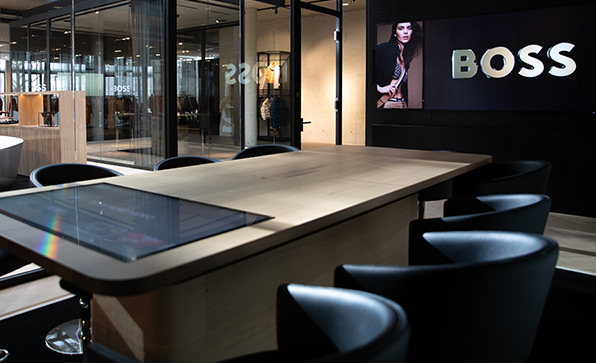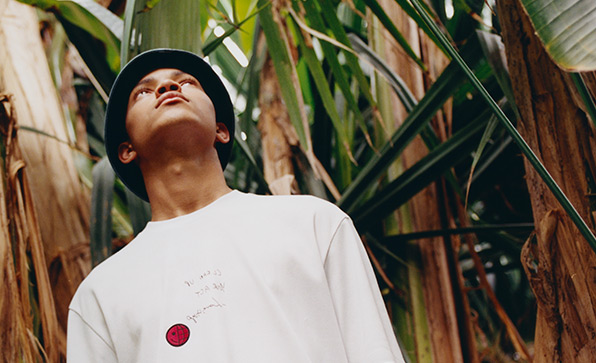Innovation and sustainability as guiding principles of R&D work
Digitalization of product development of high strategic relevance
Share of particularly sustainable Responsible styles further increased
The goal of research and development (R&D) at HUGO BOSS is to develop collections and products that meet the highest customer demands in terms of quality and fit, as well as innovation and sustainability. These requirements are in line with the strategic claim “Product is King” – a key element of “CLAIM 5” – which puts the product at the center of its strategy. In the coming years, the Company will focus on further optimizing the price-value proposition in order to guarantee premium quality, a high degree of innovation and sustainability and features that enable its brands to clearly distinguish from the competition. The potential of digitalization is to be fully exploited throughout the entire product development process. Inspiring capsule collections and exceptional collaborations with well-known brands and personalities are also intended to spur the brand relevance of BOSS and HUGO in future. Group Strategy, “Product is King”
Research and development at HUGO BOSS runs along the product development process, which involves the transformation of a creative idea into a commercial product. The work is carried out at three development centers in Metzingen (Germany), Coldrerio (Switzerland), and Morrovalle (Italy). While the majority of the collections are developed at the Group headquarters in Metzingen, the Coldrerio site is mainly responsible for the development of the product groups shirts, knitwear, and shoes and accessories. In Morrovalle, HUGO BOSS develops high-quality shoes and leather accessories.
Product development process
Product development process at HUGO BOSS
The product development process starts with a creative idea, taking into account customers’ expectations. Collections are themed based on brand strategy, brand values as well as global mega and fashion trends. To ensure a holistic brand message, collection and brand communication are closely aligned right from the start of the development process. The transformation of the creative idea and designs into specific collections also takes into account sell-through rates of previous seasons. In the conventional development process, the second step sees the design teams’ creative ideas tailored in the pattern design phase. Technical product development then turns the models into prototypes and tests their suitability for the industrial production process. In conventional product development, the prototyping is followed by the manufacture of a sample collection in order to ensure that the products meet the Company’s high standards in terms of quality and fit. Once production has been completed, the collections are finally delivered to wholesale partners and the Group’s own retail stores.
>90%
Digital developed
products
in 2025
The digitalization of collection development is of high strategic importance to HUGO BOSS. In line with its strategic claims “Lead in Digital” and “Organize for Growth”, the Company has set itself the goal of developing more than 90% of its products digitally by 2025 (2021: around 50%). Also in fiscal year 2021, HUGO BOSS was able to significantly advance the digitalization of collection development. For example, the BOSS Spring/Summer 2022 casualwear collection was developed fully digitally for the first time. From first sketches and the selection of materials and colors to prototyping and to the finished collection, the process was completely digitalized. The digital workflows allow the Company to operate more flexibly throughout its entire value chain, shorten lead times and adapt more effectively and quickly to current consumer trends. In the medium term, this should reduce lead times by around 30%. In addition, the digitally developed styles are also used in distribution – for example, when selling the collections to wholesalers via digital showrooms or in “virtual fitting” on hugoboss.com.

NEW Digital
Digital will be key for our success as today, the customer journey starts online. That’s why we will significantly improve the customer experience by leveraging data.
Learn more Learn moreIn 2021, the company also made progress in reducing complexity within the BOSS and HUGO collections. The Modular Creation Toolbox introduced in 2021 is intended to achieve further efficiencies in the future, for example with regard to the use of materials and patterns. The toolbox serves product developers as a digital database for cuts, fabrics, and other components, including a 3D visualization of the digitally designed garments. It is initially used for the development of jersey products and shirts, and is intended to further increase speed and efficiency in the development process as well as optimize the use of materials. In the development of the Fall/Winter 2023 collection, the patterns developed digitally using the Modular Creation Toolbox will already form the basis for the majority of the basic and core products in the collection.
Key areas of research and development
The Company pursues the clear ambition of establishing BOSS as a true 24/7 lifestyle brand, perfectly dressing its customers for all wearing occasions, with casualness and comfort being the guiding principles. As the first point of contact for younger consumers, HUGO focuses on a wide range of trendy and modern products that reflect the brand’s authentic and unconventional style. The Company aims to gradually drive casualization along the BOSS and HUGO collections and further optimize wearing comfort through the use of innovative materials. The boundaries between traditional business and modern casualwear are to be further blurred and the classic tailoring range is to be increasingly expanded to include innovative casual-tailoring combinations. 2021 saw the successful launch of the BOSS Performance product range, which combines formalwear outfits even more closely with sportswear elements. Through the use of innovative materials, it further increases wearing comfort for customers. In this context, BOSS has introduced the “Air Weight Suit” with its Spring/Summer 2022 collection, which is characterized by a particularly high level of comfort and freedom of movement. Due to its material composition, the suit is also particularly durable and can therefore be easily carried in hand luggage, for example. Group Strategy, “Product is King”
In addition to the important main collections, which offer customers both a broad range of basic and core products and a variety of seasonal and particularly fashion-conscious styles, in the future HUGO BOSS will focus on particularly high-growth product groups such as denim and bodywear as part of “CLAIM 5”. In addition, inspiring capsule collections and exceptional collaborations are intended to increase the brand relevance of BOSS and HUGO. In this context, and to underscore its ambitions as a true 24/7 lifestyle brand, BOSS has teamed up with American sportswear brand Russell Athletic to develop two capsule collections in 2021 that combine BOSS’ high level of tailoring expertise with the sportswear aesthetic of Russell Athletic. The highly recognizable menswear and womenswear styles are inspired by the strong team spirit of sports and were particularly well received by younger customers. In 2021, BOSS also launched two capsule collections together with the National Basketball Association (NBA). Also here, it were particularly younger customers who responded very well to the logo-inspired sportswear products, which gave a further boost to the brand’s casualwear business, especially in the important U.S. market. Exceptional collaborations like these will continue to play a key role in attracting younger target groups to HUGO BOSS and fully exploiting the great potential of both brands in the future.

NEW Materials
Sustainability is at the core of HUGO BOSS. We are looking for best‑in‑class solutions having a measurable impact on the environment, aiming at climate neutrality and establishing a circular business model.
Learn more Learn moreAt the same time, both brands – BOSS and HUGO – are committed to living up to the growing customer expectations in terms of sustainability. To this end, the Company is increasingly relying on innovative, sustainable materials and manufacturing techniques in the development of its collections. In this context, the share of particularly sustainable RESPONSIBLE styles in the product range of BOSS and HUGO is to increase to 60% by 2030 (2021: 31%). A significant contribution in 2021 was made by the development of “BOSS ONE – The Suit”, which is made from sustainable wool, enabling customers to trace it seamlessly along the entire supply chain. Furthermore, HUGO launched the sustainability initiative “Clean Up Your Act” for the Fall/Winter 2021 collection. Among the products were parkas made from upcycled and reused fabric scraps and sportswear made from sustainable cotton. In 2022, to mark World Water Day in March, BOSS will launch a “Less Water” capsule collection that features the use of environmentally friendly and water-saving materials. To further drive the innovative strength and sustainability of its brands, HUGO BOSS has also entered into a long-term strategic partnership with HeiQ AeoniQ in early 2022. This partnership focuses on the production of a sustainable, circular and recyclable cellulose yarn with the aim of replacing oil-based fibers such as environmentally harmful polyester and nylon. Sustainability
R&D key figures
The creative and development departments of HUGO BOSS are staffed primarily by fashion designers, tailors, shoe and clothing technicians and engineers. As of December 31, 2021, the number of employees in research and development totaled 606 (2020: 543).
R&D expenses
At 72%, personnel expenses accounted for the majority of R&D expenses last fiscal year (2020: 76%). The remainder is primarily composed of other department expenses. In 2021, R&D costs were again mostly recognized as expenses at the time they were incurred. In addition, production-related development expenses are included in the cost of conversion of inventories. No development expenses were recognized as internally generated intangible assets due to the short product life cycles.